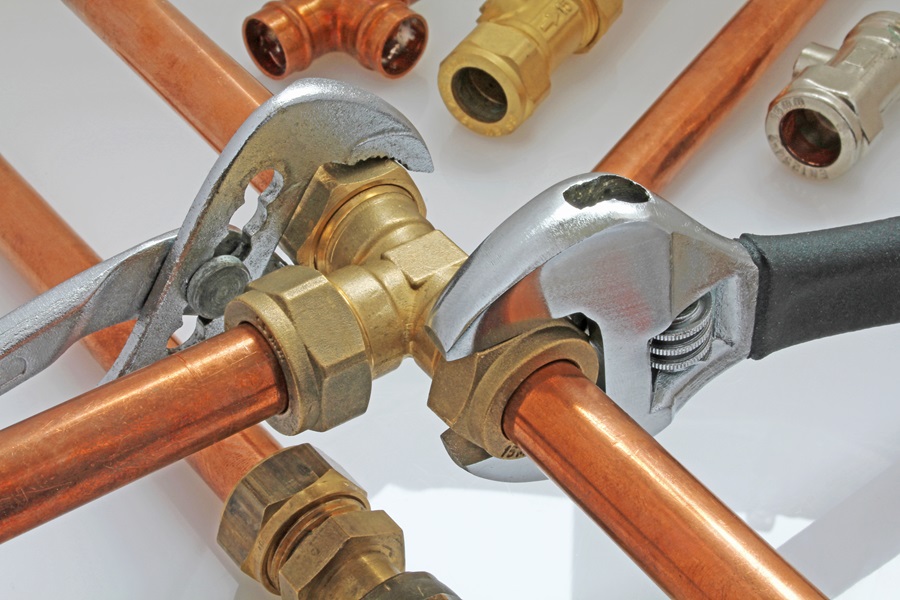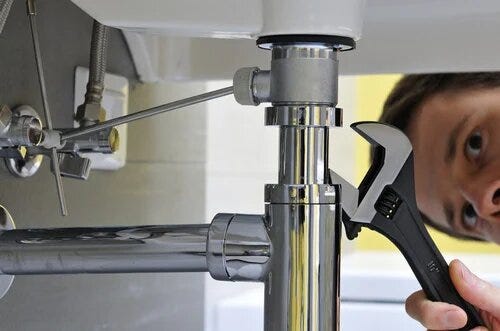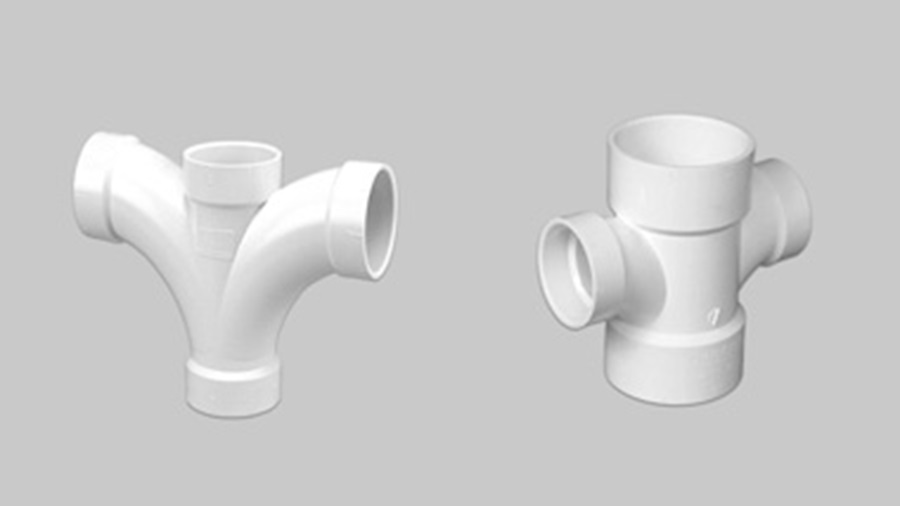To install a double tee fitting, carefully remove the existing fitting, align the new double tee fitting in the desired location, and tighten the connection securely. The process may vary depending on the specific plumbing system and materials being used.
Introduction To Double Tee Fittings
A double tee fitting is a specialized plumbing component that is used to connect two drain pipes at a 90-degree angle. It is named after its unique shape, which resembles two uppercase letter “T” positioned back to back. Double tee fittings are commonly used in plumbing installations to create a smooth and efficient flow of wastewater from one section to another.

What Is A Double Tee Fitting?
A double tee fitting, also known as a double sanitary tee, is a plumbing fitting that is used to connect two horizontal drain pipes at a 90-degree angle while allowing for a vertical drain pipe to be connected as well. It is designed with two side inlets and one top outlet, allowing for the diversion of wastewater into different pipes. This fitting is commonly made of durable materials such as PVC or ABS, ensuring its long-lasting performance.
Benefits Of Using A Double Tee Fitting
Using double tee fittings in plumbing installations offers several benefits:
- Efficient flow: Double tee fittings are designed to create a smooth flow of wastewater, reducing the chances of clogs and backups in the plumbing system.
- Versatility: These fittings can be used in various plumbing configurations, allowing for flexibility in designing drainage systems.
- Durability: Double tee fittings are made of durable materials that can withstand high pressure and resist corrosion, ensuring their longevity.
- Ease of installation: These fittings are relatively easy to install, making them a popular choice among plumbers.
Common Uses Of Double Tee Fittings
Double tee fittings are commonly used in the following plumbing applications:
- Branching pipes: Double tee fittings are often used to connect horizontal drain pipes when a vertical pipe needs to be added for additional fixtures in bathrooms or kitchens.
- Wet venting: These fittings can be used in wet venting configurations, where a fixture drains into a wet vent to prevent the accumulation of solids.
- Horizontal connections: Double tee fittings are ideal for making horizontal connections in drain pipes, allowing for efficient flow and smooth transitions between sections.
- Plumbing system expansions: When expanding a plumbing system, double tee fittings can be used to connect new fixtures to the existing drain pipes.

In conclusion, double tee fittings are essential components in plumbing installations, providing a reliable and efficient way to connect drain pipes at a 90-degree angle. Their benefits include efficient flow, versatility, durability, and easy installation. Common uses of double tee fittings include branching pipes, wet venting, horizontal connections, and plumbing system expansions.
Installation Of Double Tee Fittings
When it comes to installing double tee fittings, proper planning and preparation are crucial for a successful installation. By following a step-by-step process and employing a few tips and tricks, you can ensure a seamless installation of double tee fittings.
Preparation And Planning
Before diving into the installation process, it is essential to prepare and plan accordingly. Here are a few key steps to take:
- Gather the necessary tools and equipment, including a saw, measuring tape, adhesive, and sealant.
- Measure the area where the double tee fitting will be installed to ensure a precise fit.
- Assess the existing plumbing system and identify any necessary adjustments or modifications.
- Obtain all the required permits and consult local building codes to ensure compliance.
Step-by-step Installation Process
The installation process for double tee fittings can be broken down into the following steps:
- Start by cutting the existing pipe using a saw or appropriate cutting tool.
- Clean the cut ends of the pipe to ensure a smooth connection.
- Apply adhesive or sealant to the inner surfaces of the double tee fitting.
- Insert the cut ends of the pipes into the corresponding openings of the double tee fitting.
- Make sure the pipes are inserted fully and securely into the fitting.
- Allow the adhesive or sealant to dry according to the manufacturer’s instructions.
- Test the connection for any leaks or abnormalities.
- If necessary, make any adjustments or repairs to ensure a proper fit.
Tips And Tricks For A Successful Installation
Here are a few tips and tricks to keep in mind during the installation process:
- Ensure that the surfaces of the pipes and the double tee fitting are clean and free from debris.
- Apply adhesive or sealant sparingly but evenly to prevent excess buildup.
- Double-check the measurements and alignment before making any cuts or connections.
- Secure the double tee fitting firmly in place to prevent any movement or dislodging.
- Consider using clamps or supports for additional stability, especially in areas with high water pressure.
- Regularly inspect the installation for any signs of leaks or damage and address them promptly.
With proper preparation, a step-by-step approach, and a few handy tips, installing double tee fittings can be a straightforward and successful process. By ensuring a precise fit and secure connections, you can have confidence in the reliability and functionality of your plumbing system.
Comparison Between Double Tee Fittings And Other Fittings
When it comes to plumbing installations, choosing the right fittings is crucial for proper functionality and efficiency. In this section, we will compare double tee fittings with other commonly used fittings, highlighting the key differences and situations where each type is best suited.

Difference Between Double Tee Fittings And Single Tee Fittings
Single tee fittings, also known as standard tee fittings, are commonly used in plumbing systems to create branching connections. These fittings have a single inlet and two outlets, allowing for the connection of two pipes at perpendicular angles. On the other hand, double tee fittings are designed for more complex plumbing configurations, featuring two inlets and two outlets.
The main advantage of double tee fittings over single tee fittings is their ability to accommodate two incoming pipes, making them ideal for situations where multiple pipes need to be joined together. This can be particularly useful in scenarios where drainage flows need to change direction from horizontal to vertical or when connecting multiple fixtures to a common drain line.
When To Use Double Tee Fittings Vs. Wye Fittings
Another common fitting used in plumbing installations is the wye fitting. Wye fittings have a single inlet and two outlets, similar to single tee fittings. However, the main difference lies in the angle of the outlets. Wye fittings have a 45-degree angle, while double tee fittings have a 90-degree angle for their outlets.
Double tee fittings are typically used when a sharper change in direction is required, such as transitioning from a horizontal drain line to a vertical stack. The 90-degree angle of the outlets allows for a more abrupt change in flow direction, ensuring efficient drainage. On the other hand, wye fittings are often used in situations where a more gradual change in flow direction is needed, such as connecting fixtures to a main drain line.
Comparison Of Double Tee Fittings And Other Common Fittings
Here is a comparison table highlighting the differences between double tee fittings, single tee fittings, and wye fittings:
| Fitting Type | Number of Inlets | Number of Outlets | Outlet Angle | Main Usage |
|---|---|---|---|---|
| Double Tee Fittings | 2 | 2 | 90 degrees | Connecting multiple pipes at sharp angles |
| Single Tee Fittings | 1 | 2 | 90 degrees | Creating branching connections at perpendicular angles |
| Wye Fittings | 1 | 2 | 45 degrees | Connecting fixtures to main drain lines with a gradual change in flow direction |
Understanding the differences between these fittings can help you make the right choice for your specific plumbing needs. Whether you require a sharper change in flow direction or a gradual transition, selecting the appropriate fitting will ensure proper drainage and avoid any issues down the line.
Frequently Asked Questions Of How To Install A Double Tee Fitting
When Would You Use A Double Sanitary Tee?
A double sanitary tee is used when there is a change in direction of drainage flow from horizontal to vertical. It has less sweep to the side inlets compared to a regular sanitary tee.
What Is The Difference Between Wye And Double Sanitary Tee?
A Wye fitting is used for drainage flows that change direction from horizontal to vertical. A double sanitary tee has less side inlet sweep and is not suitable for horizontal installation.
Can I Use A Double Sanitary Tee Horizontally?
No, you cannot use a double sanitary tee horizontally. It is not allowed because it has a horizontal dry vent take off, which is not permitted. The only time a vent can connect horizontally is if it is a wet vent, where the fixture draining into the wet vent prevents the accumulation of solids.
Can A Double Wye Be Installed Horizontally?
Yes, a double wye can be installed horizontally. It is commonly used by plumbers, although some prefer using two wyes for better tilt and grade. However, it is important to ensure that water does not flow up the other arm and that all plumbing code requirements are met.
Conclusion
Installing a double tee fitting can be a straightforward process when done correctly. By following the necessary steps and guidelines, you can ensure a secure and reliable connection for your plumbing system. Remember to carefully choose the right fittings and consider the direction of drainage flow.
With the proper installation, you can have peace of mind knowing that your plumbing system is functioning efficiently. By taking the time to install a double tee fitting properly, you can prevent any potential issues and maintain the longevity of your plumbing system.




